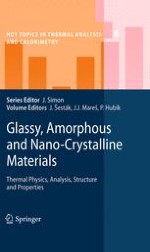2011 | OriginalPaper | Buchkapitel
19. Thermophysical Properties of Natural Glasses at the Extremes of the Thermal History Profile
verfasst von : Paul Thomas, Jaroslav Šesták, Klaus Heide, Ekkehard Füglein, Peter Šimon
Erschienen in: Glassy, Amorphous and Nano-Crystalline Materials
Verlag: Springer Netherlands
Aktivieren Sie unsere intelligente Suche, um passende Fachinhalte oder Patente zu finden.
Wählen Sie Textabschnitte aus um mit Künstlicher Intelligenz passenden Patente zu finden. powered by
Markieren Sie Textabschnitte, um KI-gestützt weitere passende Inhalte zu finden. powered by
